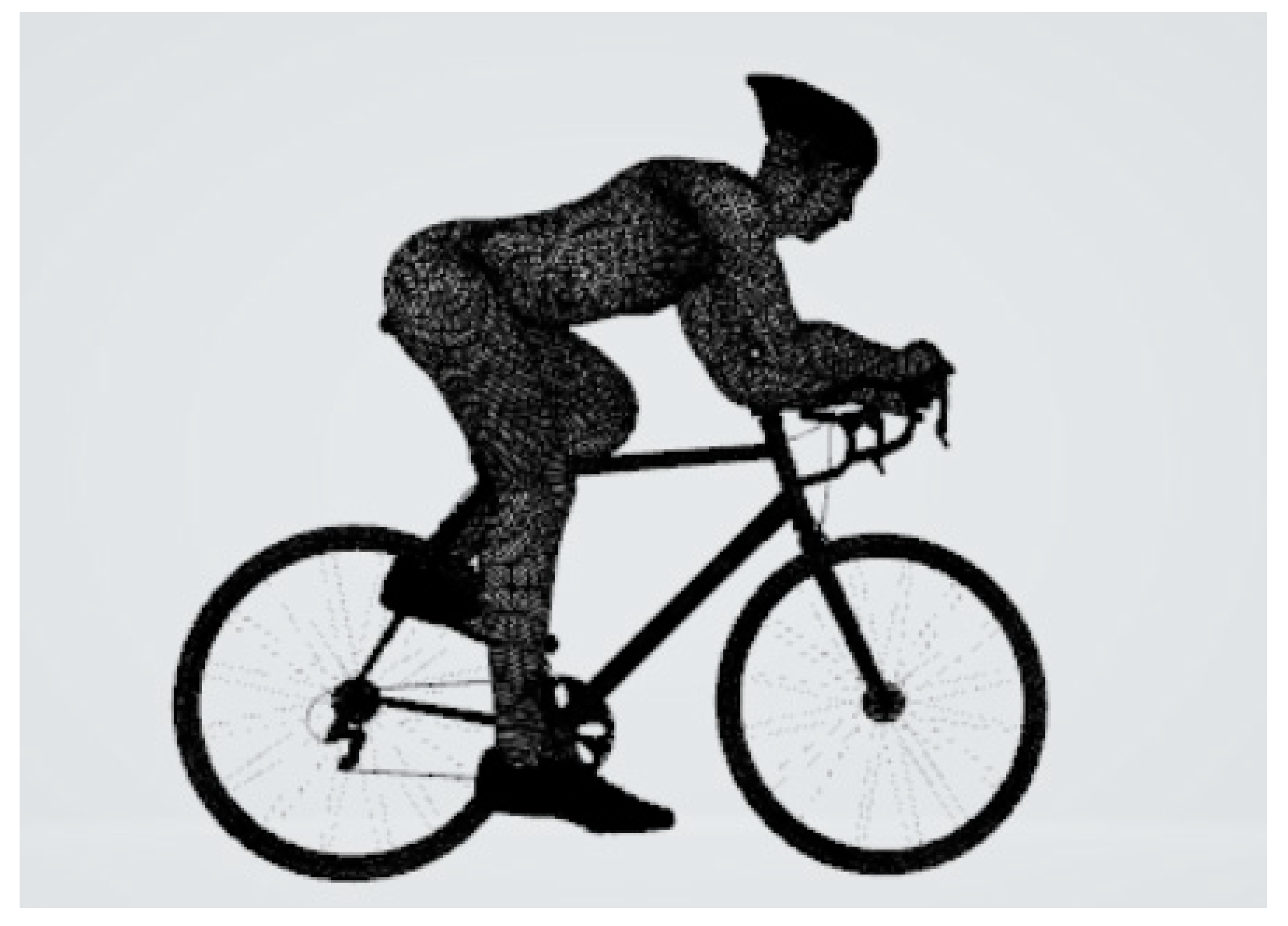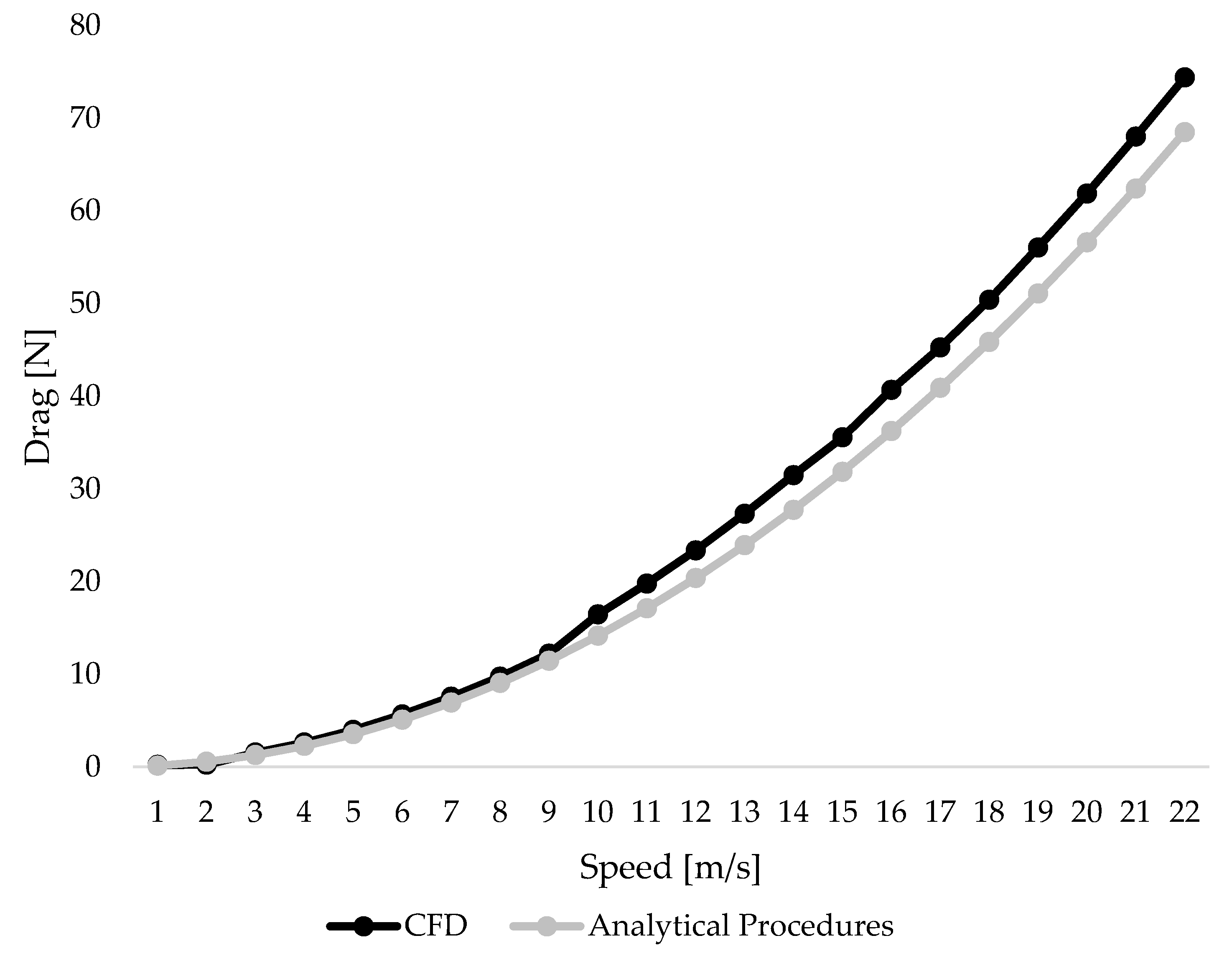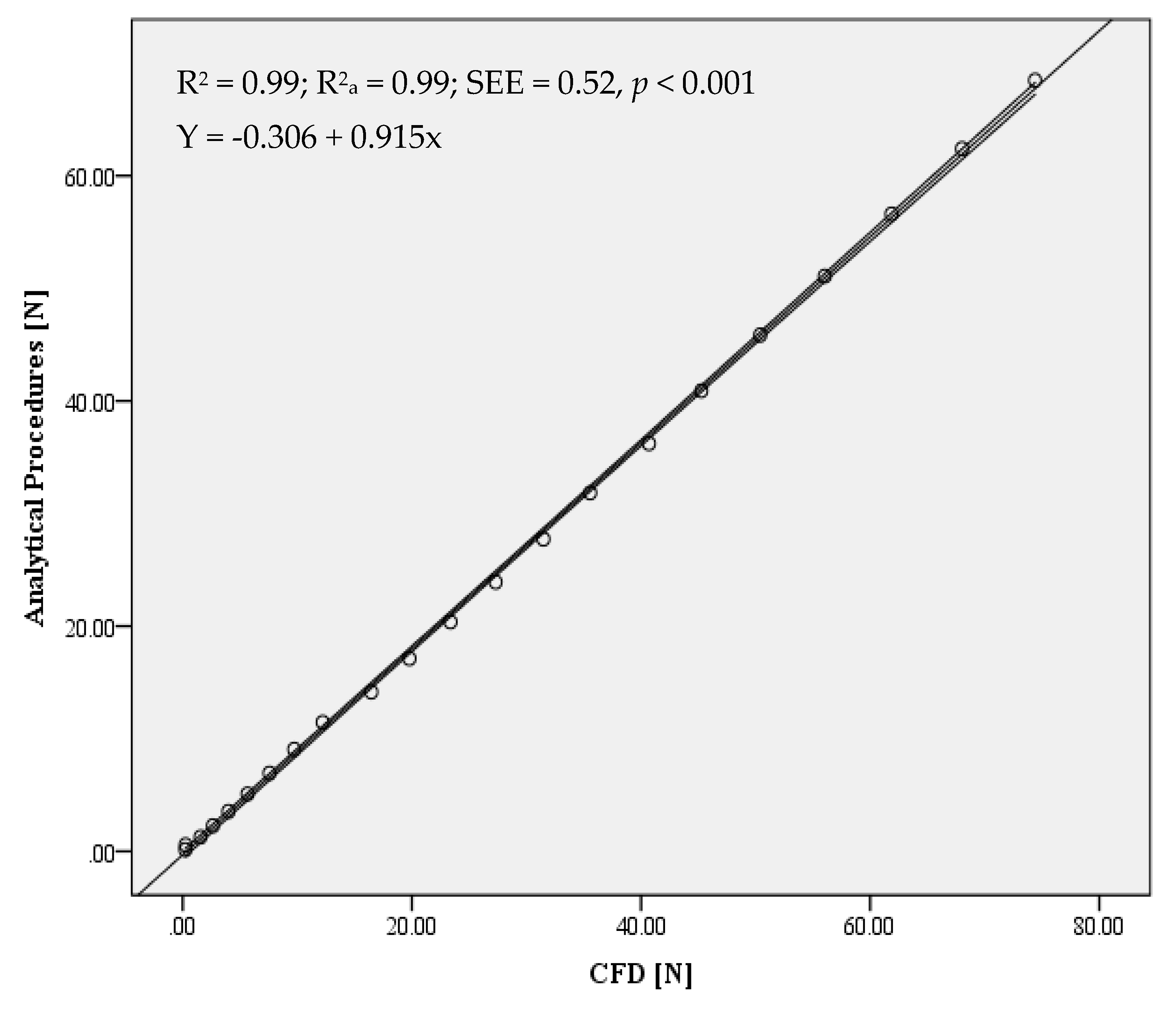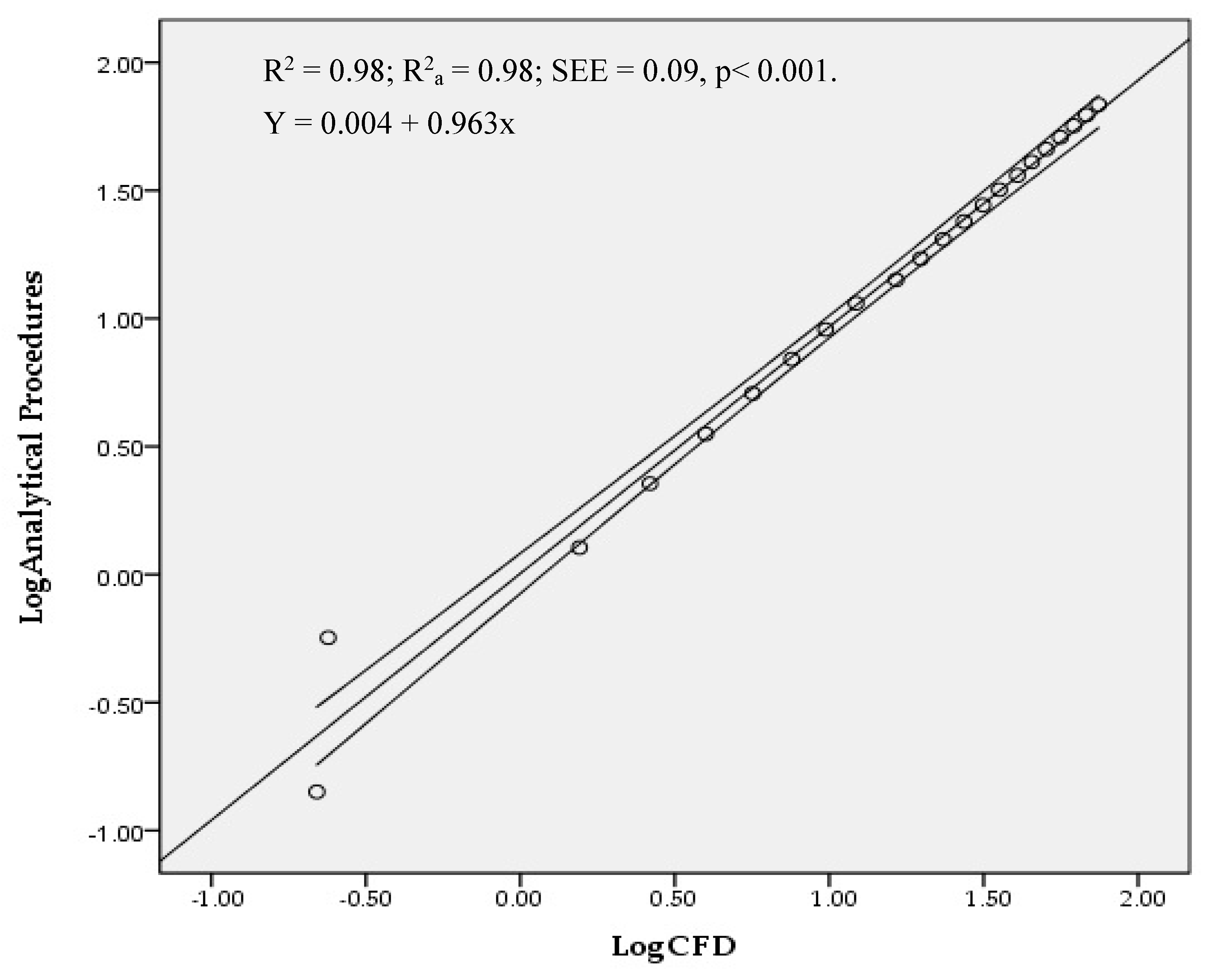Analysis of Cyclist’s Drag on the Aero Position Using Numerical Simulations and Analytical Procedures: A Case Study
Abstract
1. Introduction
2. Materials and Methods
2.1. Sample
2.2. Scanning
2.3. Boundaries
2.4. Numerical Simulations
2.5. Analytical Procedures
2.6. Statistical Analysis
3. Results
4. Discussion
5. Conclusions
Author Contributions
Funding
Conflicts of Interest
References
- Kräuter, N.; Lösing, S.; Bauer, G.; Schwering, L.; Seuter, M. Supporting safety in cycling groups using LED-augmented gestures. In Proceedings of the 2016 ACM International Joint Conference on Pervasive and Ubiquitous Computing, Heidelberg, Germany, 12–16 September 2016; Adjunct: New York, NY, USA, 2016; pp. 889–892. [Google Scholar]
- Lucia, A.; Earnest, C.; Arribas, C. The Tour de France: A physiological review. Scand. J. Med. Sci. Sports 2003, 13, 275–283. [Google Scholar] [CrossRef] [PubMed]
- Martin, J.C.; Milliken, D.L.; Cobb, J.E.; McFadden, K.L.; Coggan, A.R. Validation of a mathematical model for road cycling power. J. Appl. Biomech. 1998, 14, 276–291. [Google Scholar] [CrossRef] [PubMed]
- Grappe, F.; Candau, R.; Barbier, B.; Hoffman, M.D.; Belli, A.; Rouillon, J.D. Influence of tyre pressure and vertical load on coefficient of rolling resistance and simulated cycling performance. Ergonomics 1999, 42, 1361–1371. [Google Scholar] [CrossRef]
- Defraeye, T.; Blocken, B.; Koninckx, E.; Hespel, P.; Carmeliet, J. Aerodynamic study of different cyclist positions: CFD analysis and full-scale wind-tunnel tests. J. Biomech. 2010, 43, 1262–1268. [Google Scholar] [CrossRef]
- Blocken, B.; van Druenen, T.; Toparlar, Y.; Andrianne, T. Aerodynamic analysis of different cyclist hill descent positions. J. Wind. Eng. Ind. Aerodyn. 2018, 181, 27–45. [Google Scholar] [CrossRef]
- Grappe, F.; Candau, R.; Belli, A.; Rouillon, J.D. Aerodynamic drag in field cycling with special reference to the Obree’s position. Ergonomics 1997, 40, 1299–1311. [Google Scholar] [CrossRef]
- Barelle, C.; Chabroux, V.; Favier, D. Modelling of the time trial cyclist projected frontal area incorporating anthropometric, postural and helmet characteristics. Sports Eng. 2010, 12, 199–206. [Google Scholar] [CrossRef]
- Beaumont, F.; Taiar, R.; Polidori, G.; Trenchard, H.; Grappe, F. Aerodynamic study of time-trial helmets in cycling racing using CFD analysis. J. Biomech. 2018, 67, 1–8. [Google Scholar] [CrossRef]
- Forte, P.; Barbosa, T.M.; Marinho, D.A. Technologic Appliance and Performance Concerns in Wheelchair Racing—Helping Paralympic Athletes to Excel. In New Perspectives in Fluid Dynamics; Liu, C., Ed.; IntechOpen: Rijeka, Croatia, 2015; pp. 101–121. [Google Scholar]
- Forte, P.; Marinho, D.A.; Barbosa, T.M.; Morais, J.E. Analysis of a normal and aero helmet on an elite cyclist in the dropped position. AIMS Biophys. 2020, 7, 54–64. [Google Scholar] [CrossRef]
- Heil, D.P. Body mass scaling of projected frontal area in competitive cyclists. Eur. J. Appl. Physiol. 2001, 85, 358–366. [Google Scholar] [CrossRef]
- Forte, P.; Marinho, D.A.; Morais, J.E.; Morouço, P.G.; Barbosa, T.M. The variations on the aerodynamics of a world-ranked wheelchair sprinter in the key-moments of the stroke cycle: A numerical simulation analysis. PLoS ONE 2018, 13, e0193658. [Google Scholar] [CrossRef] [PubMed]
- Barbosa, T.M.; Ramos, R.; Silva, A.J.; Marinho, D.A. Assessment of passive drag in swimming by numerical simulation and analytical procedure. J. Sports Sci. 2018, 36, 492–498. [Google Scholar] [CrossRef] [PubMed]
- Barbosa, T.M.; Morais, J.E.; Forte, P.; Neiva, H.; Garrido, N.D.; Marinho, D.A. Correction: A Comparison of Experimental and Analytical Procedures to Measure Passive Drag in Human Swimming. PLoS ONE 2017, 12, e0177038. [Google Scholar] [CrossRef] [PubMed]
- Blocken, B.; Defraeye, T.; Koninckx, E.; Carmeliet, J.; Hespel, P. CFD simulations of the aerodynamic drag of two drafting cyclists. Comput. Fluids 2013, 71, 435–445. [Google Scholar] [CrossRef]
- Dorel, S.; Hautier, C.A.; Rambaud, O.; Rouffet, D.; Praagh, E.V.; Lacour, J.-R.; Bourdin, M. Torque and Power-Velocity Relationships in Cycling: Relevance to Track Sprint Performance in World-Class Cyclists. Int. J. Sports Med. 2005, 26, 739–746. [Google Scholar] [CrossRef] [PubMed]
- Aroussi, A.; Kucukgokoglan, S.; Pickering, S.J.; Menacer, M. Evaluation of four turbulence models in the interaction of multi burners swirling flows. In Proceedings of the 4th International Conference on Multiphase Flow, New Orleans, LA, USA, 27th May–1st June 2001. [Google Scholar]
- Faria, E.W.; Parker, D.L.; Faria, I.E. The Science of Cycling: Factors Affecting Performance—Part 2. Sports Med. 2005, 35, 313–337. Available online: http://adisonline.com/sportsmedicine/Abstract/2005/35040/The_Science_of_Cycling__Factors_Affecting.3.aspx (accessed on 27 March 2020). [CrossRef]
- Heil, D.P. Body size as a determinant of the 1-h cycling record at sea level and altitude. Eur. J. Appl. Physiol. 2005, 93, 547–554. [Google Scholar] [CrossRef]
- Buchheit, M. Chasing the 0.2. Int. J. Sports Physiol. Perform 2016, 11, 417–418. [Google Scholar] [CrossRef]
- Blocken, B.; van Druenen, T.; Toparlar, Y.; Malizia, F.; Mannion, P.; Andrianne, T.; Diepens, J. Aerodynamic drag in cycling pelotons: New insights by CFD simulation and wind tunnel testing. J. Wind Eng. Ind. Aerodyn. 2018, 179, 319–337. [Google Scholar] [CrossRef]
- Griffith, M.D.; Crouch, T.; Thompson, M.C.; Burton, D.; Sheridan, J. Elite cycling aerodynamics: wind tunnel experiments and CFD. In Proceedings of the 18th Australasian Fluid Mechanics Conference, Tasmania, Australia, 3–7 December 2012. [Google Scholar]
- Blocken, B.; Toparlar, Y. A following car influences cyclist drag: CFD simulations and wind tunnel measurements. J. Wind Eng. Ind. Aerodyn. 2015, 145, 178–186. [Google Scholar] [CrossRef]
- Bixler, B.; Pease, D.; Fairhurst, F. The accuracy of computational fluid dynamics analysis of the passive drag of a male swimmer. Sports Biomech. 2007, 6, 81–98. [Google Scholar] [CrossRef] [PubMed]
- Candau, R.B.; Grappe, F.; Menard, M.; Barbier, B.; Millet, G.Y.; Hoffman, M.D.; Rouillon, J.D. Simplified deceleration method for assessment of resistive forces in cycling. Med. Sci. Sports Exerc. 1999, 31, 1441–1447. [Google Scholar] [CrossRef] [PubMed]




© 2020 by the authors. Licensee MDPI, Basel, Switzerland. This article is an open access article distributed under the terms and conditions of the Creative Commons Attribution (CC BY) license (http://creativecommons.org/licenses/by/4.0/).
Share and Cite
Forte, P.; Marinho, D.A.; Nikolaidis, P.T.; Knechtle, B.; Barbosa, T.M.; Morais, J.E. Analysis of Cyclist’s Drag on the Aero Position Using Numerical Simulations and Analytical Procedures: A Case Study. Int. J. Environ. Res. Public Health 2020, 17, 3430. https://doi.org/10.3390/ijerph17103430
Forte P, Marinho DA, Nikolaidis PT, Knechtle B, Barbosa TM, Morais JE. Analysis of Cyclist’s Drag on the Aero Position Using Numerical Simulations and Analytical Procedures: A Case Study. International Journal of Environmental Research and Public Health. 2020; 17(10):3430. https://doi.org/10.3390/ijerph17103430
Chicago/Turabian StyleForte, Pedro, Daniel A. Marinho, Pantelis T. Nikolaidis, Beat Knechtle, Tiago M. Barbosa, and Jorge E. Morais. 2020. "Analysis of Cyclist’s Drag on the Aero Position Using Numerical Simulations and Analytical Procedures: A Case Study" International Journal of Environmental Research and Public Health 17, no. 10: 3430. https://doi.org/10.3390/ijerph17103430
APA StyleForte, P., Marinho, D. A., Nikolaidis, P. T., Knechtle, B., Barbosa, T. M., & Morais, J. E. (2020). Analysis of Cyclist’s Drag on the Aero Position Using Numerical Simulations and Analytical Procedures: A Case Study. International Journal of Environmental Research and Public Health, 17(10), 3430. https://doi.org/10.3390/ijerph17103430









